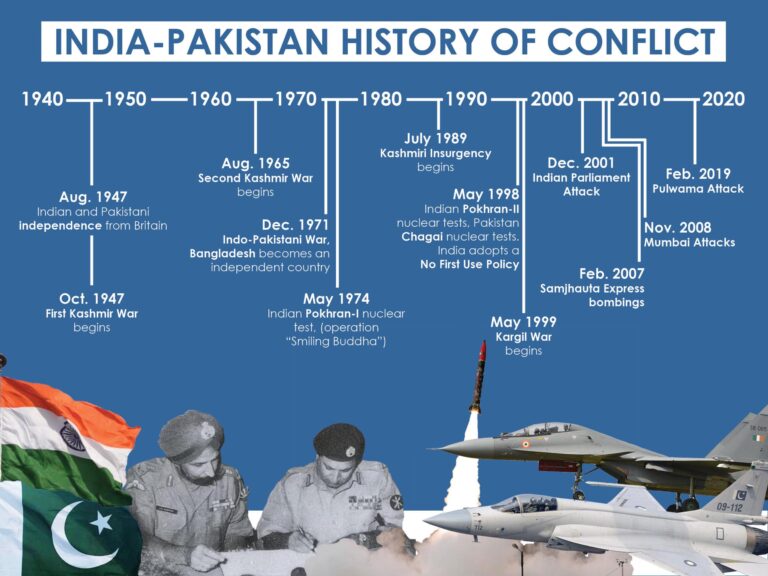The Potential Conflict Between India and Pakistan: A Critical Standoff with Global Consequences
As tensions between India and Pakistan rise once more, the threat of military conflict casts a long shadow over South Asia. In recent months, both countries have considerably increased their military readiness, leading to more frequent skirmishes along the Line of Control. With enduring issues such as Kashmir and terrorism at the forefront, fears of a fifth major war between these nuclear-capable nations have escalated concerns not only regionally but also on a global scale. Experts caution that the stakes are unprecedentedly high; an explosive combination of national pride, historical grievances, and geopolitical alliances could potentially involve larger powers and disrupt the already fragile security framework in the Indo-Pacific region.This article explores the current dynamics at play, identifies key stakeholders involved, and examines potential outcomes of any future conflict while emphasizing the urgent need for diplomatic efforts amid rising tensions.
Military Preparations: Understanding Movements Along the Indo-pakistani Border
The recent surge in military activities along the Indo-Pakistani border has raised alarm bells regarding a possible resurgence of hostilities between these two nuclear-armed states. Both nations are strategically enhancing their defenses and increasing troop deployments in sensitive regions near the Line of Control.Several factors contribute to this escalation:
- Troop Concentration: Both India and Pakistan have significantly increased troop numbers in critical areas.
- Artillery exchanges: Reports indicate heightened artillery fire across borders resulting in civilian casualties.
- Intelligence Operations: Enhanced surveillance measures by both countries aim to secure strategic advantages.
An examination of recent military drills conducted by both sides indicates a shift towards rapid mobilization strategies focused on offensive capabilities. Evidence suggests that Pakistan is enhancing its asymmetric warfare capabilities while India is concentrating on strengthening its conventional forces. A comparative overview reveals stark differences in their military assets:
| Nation | Active Military Personnel | Main Battle Tanks | Fighter Aircrafts |
|---|---|---|---|
| India | 1,450,000 | 4,800 | 600 |
| Pakistan |
This ongoing arms buildup raises serious questions about regional stability as both nations confront their respective military realities. While diplomatic initiatives aimed at reducing tensions remain essential yet ineffective thus far—leading some analysts to predict an unstable future—the international community remains vigilant about potential responses as fears grow regarding an imminent conflict.
Global Powers’ Role: Navigating Diplomatic Challenges Amidst Stalemate
The persistent discord between India and Pakistan continues to pose challenges for south Asian stability while attracting interest from global powers eager to mediate solutions. Though, complexities arising from national pride coupled with historical disputes complicate these mediation efforts significantly. Countries likeThe United States,<strong China,and<strong Russia, each with distinct strategic interests at stake attempt to act as intermediaries:
- United States : Historically allied with Pakistan ,the U.S .also engages with India for counterterrorism collaboration aimed at maintaining regional security .
- China : As a steadfast ally ,China seeks balance against India’s growing influence especially through investments within projects like China-Pakistan Economic Corridor .
- Russia : Strengthening ties with India allows Russia room for facilitating dialog whilst simultaneously improving relations across both nations .
A pragmatic resolution remains elusive despite various diplomatic attempts; diverging national interests often lead back into stalemate territory where temporary agreements dissolve into renewed hostilities quickly enough . Below is another comparative analysis reflecting ongoing tension through respective defense budgets :
| Nation | Total Active Military Personnel | Total Defense Budget (USD Billion) | Nuclear Arsenal | ||
|---|---|---|---|---|---|
| India | 70 | 150-160 | |||
| Pakistan |
Strategies for Peace: Recommendations for De-escalation & Collaboration
To prevent impending conflicts between India &Pakistan ,a comprehensive approach prioritizing diplomacy alongside long-term strategies becomes vital.Both parties should engage regularly via established frameworks such as Composite Dialogue Mechanism covering bilateral issues including Kashmir trade cultural exchanges.Additionally creating joint task forces addressing shared challenges like water management cross-border terrorism would enhance cooperation further.A dedicated hotline For Crisis Management could facilitate immediate dialogue among military leaders acting effectively against misunderstandings escalating situations .
Moreover civil society plays crucial roles fostering peace mutual understanding.Initiatives promoting people-to-people contact—such educational sports artistic exchanges—can cultivate trust collaboration.Supporting grassroots organizations advocating peace proves equally vital rallying public support around de-escalation efforts.Exploring economic cooperation opportunities within joint ventures sectors energy trade may render costs associated conflicts higher than benefits derived from collaboration.Prioritizing these strategies enables pathways toward peaceful futures.
Conclusion
As tensions persistently simmer between Indian & Pakistani borders looming threats arise concerning potential conflicts overshadowing South Asia.The intricate interplay geopolitical dynamics historical grievances nationalism raises pressing inquiries surrounding prospects peace within this region.In times where stakes escalate dramatically it becomes imperative that both governments navigate carefully avoiding miscalculations leading catastrophic consequences.Diplomacy dialogue commitment understanding perspectives essential de-escalating situation.As global observers maintain vigilance hope lingers cooler heads prevail fostering stability cooperation amidst strife-ridden landscapes ahead months prove pivotal determining whether cycles conflict can be broken or if history destined repeat itself once again.




